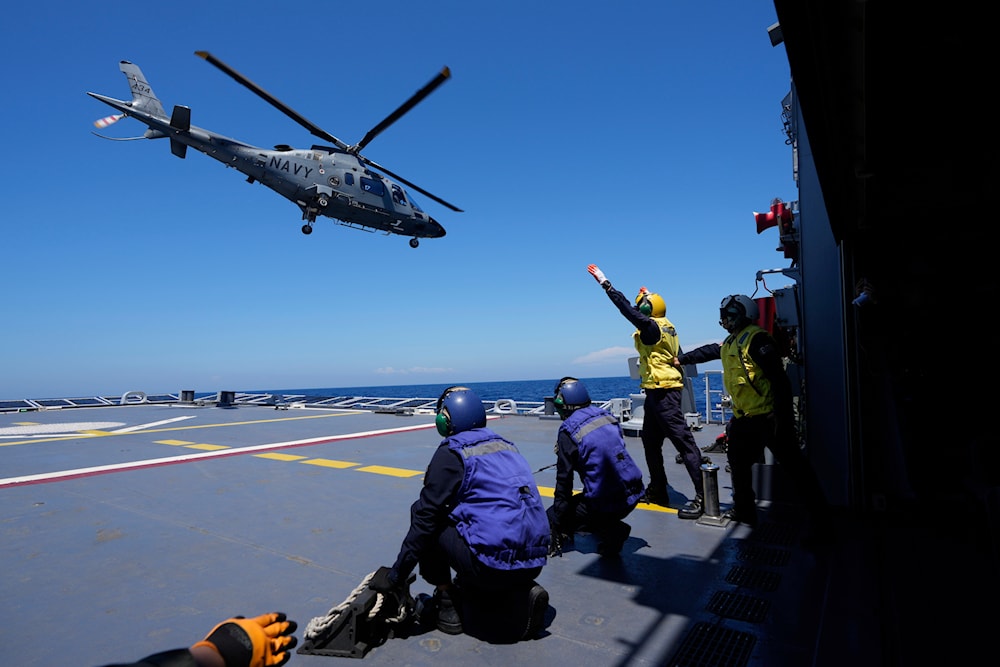US, Philippines launch joint military drills amid rising tensions
Military cooperation between the United States and the Philippines has expanded notably since President Ferdinand Marcos took office in 2022.
-
 A Philippine Navy AW109 helicopter takes off from Philippine Navy Ship Jose Rizal during the Philippines-United States-Japan Multilateral Maritime Cooperative Activity off a disputed South China Sea shoal on Friday, March 28, 2025. (AP)
A Philippine Navy AW109 helicopter takes off from Philippine Navy Ship Jose Rizal during the Philippines-United States-Japan Multilateral Maritime Cooperative Activity off a disputed South China Sea shoal on Friday, March 28, 2025. (AP)
The Philippine and US air forces began joint exercises on Monday aimed at strengthening operational coordination and enhancing “strategic deterrence,” according to the Philippine military. The drills come amid rising concerns in Beijing over what it sees as increasingly hazardous US activity near its borders.
A larger-scale set of air, land, and sea exercises between the two allies is scheduled for later this month.
Philippine Air Force commander Arthur Cordura said the Cope Thunder exercise would focus on “enhancing combat readiness and elevating joint mission effectiveness” during a launch ceremony on Monday.
Military cooperation between the United States and the Philippines has expanded notably since President Ferdinand Marcos took office in 2022.
The pace of alliance is accelerating
The US State Department last week greenlit a long-anticipated sale of F-16 fighter jets to the Philippines, although Manila clarified the agreement is “still in the negotiation phase.”
US Major General Christopher Sheppard said during the ceremony, “The pace of our alliance is accelerating,”
Simultaneously, China issued a warning to the Philippines last Wednesday, cautioning against actions that could jeopardize “regional peace,” following the US announcement approving a potential $5.58 billion sale of F-16 fighter jets to Manila.
“The Philippines’ defense and security cooperation with other countries should not target any third party or harm the interests of a third party,” said foreign ministry spokesperson Guo Jiakun. “Nor should it threaten regional peace and security or exacerbate regional tensions,” he added.
Running through April 18, Cope Thunder is designed to boost “asymmetric warfare capabilities,” operational synergy, and broader deterrence strategy, the Philippine Air Force noted.
Cordura also pointed to what lies ahead, stating, “Further down the road, we look forward to the seamless transition to exercise Balikatan, which will continue to push the boundaries of our interoperability.”
Both Cope Thunder and the upcoming Balikatan exercises are largely set to take place on Luzon, the northernmost major island in the Philippines and the closest to Taiwan.
Meanwhile, Philippine military chief Romeo Brawner cautioned that the Philippines would “inevitably” be involved if Beijing were "to invade the self-governed island."
Although Manila later clarified that Brawner’s comments primarily referenced contingency planning for evacuating Filipino workers in Taiwan, the US-Philippine Enhanced Defense Cooperation Agreement (EDCA) gives American forces access to nine military bases across the archipelago. One such base, a naval facility in Santa Ana, Cagayan, lies just 400 kilometers (250 miles) from Taiwan.
During a recent visit to Manila, US Defense Secretary Pete Hegseth reaffirmed Washington’s commitment to the alliance, saying, “Deterrence is necessary around the world, but specifically in this region, in your country — considering the threats from the Communist Chinese.”
The wider context
The launch of joint US-Philippines air drills highlights a marked escalation in regional tensions, as the two allies push forward with expanded military cooperation despite Beijing’s strong objections. Conducted near Taiwan, which China asserts as being its territory, and featuring advanced combat capabilities, the exercises are seen by China as a direct provocation and a challenge to its territorial claims.
Though officials in Manila describe the drills as defensive and routine, their scale, timing, and location suggest a more assertive posture that risks further inflaming an already volatile security environment. Rather than promoting stability, these moves are likely to provoke Beijing and increase the likelihood of miscalculation in a region already on edge.
Read next: China warns US South China Sea ops risk deadly accidents: Global Times

 4 Min Read
4 Min Read










